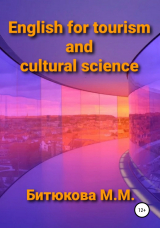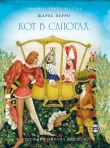
Текст книги "English for tourism and cultural science"
Автор книги: М. Битюкова
Жанр:
Иностранные языки
сообщить о нарушении
Текущая страница: 3 (всего у книги 3 страниц)
3. Using the phrases from ex. 2 make up 5 your own sentences in Russian and in English on two separate pieces of paper.
Creative Tasks
The situation: Student A is a manager of a tour agency. Student B is a tourist who wants to visit St. Petersburg. He comes to the tour agency and asks for advice what to see in the city.
Use your imagination and information from the texts and make up a dialogue.
Revision Tasks
Choose any Russian city (except Moscow and St. Petersburg) – a tourist attraction – and prepare a short presentation according to the following plan:

Unit 3. England. London
Historical Review
London is the capital and largest urban area of both England and the United Kingdom. It is the largest city in the European Union and the ninth-largest city in the world. It has a very interesting and long history which spans nearly 2,000 years, beginning with the arrival of the Romans soon after their invasion of Britain in AD43.
The Romans (A43– 410). They laid out buildings, streets and a port, and shortly afterwards they built a bridge. They called the settlement Londinium and it soon became the capital of Roman Britain.
The Saxons and the Vikings. Later in the 5th century, Anglo-Saxons settled just west of Londinium and formed the town of Lundenwic. Saxon London consisted of many wooden huts with thatched roofs. In 842 the Danish Vikings looted London. They burned a large part of the town.
The Vikings and Saxons ruled jointly England until 1042, when Edward the Confessor became King of both the Vikings and the Saxons. Edward the Confessor (1042-1066) built a wooden palace at Westminster. Later Parliament met here. Because of this Westminster became the seat of government not the city of London itself. Edward also built Westminster Abbey, which was consecrated a few weeks before his death.
Tudor London (1485 – 1603). In 1485 Henry VII became King, followed by Henry VIII. They were the first Tudor kings (Tudor was their family name). London grew in importance under the Tudor rule. It became the centre of trade and government.
Henry VIII created palaces such as St. James. He is also famous for closing the city monasteries in 1536, after the Roman Catholic Church refused to grant him a divorce. During the reign of Elizabeth I, the daughter of Henry VIII, London was wealthy and successful city. Theatre became popular, helped by the arrival of playwright William Shakespeare sometime between 1585 and 1593.
The River Thames was very important in Tudor times as Britain’s navy was expanded. Dockyards were built and ships were sent to explore the world.
Stuart London (1603 – 1649) (1660 – 1714). The first Stuart King, James I, came to the throne in 1603. He was already King James the Sixth of Scotland. He united the two countries under one king.
During the reign of Charles I, the second son of James I, the Civil War broke out in 1642 between supporters of the king and parliamentary forces, led by a Puritan called Oliver Cromwell. The King lost and was beheaded in London in 1649 and Britain became a republic known as the Commonwealth. In 1660 the monarchy was returned.
London suffered two disasters in later Stuart years: the Great Plague in 1665 which killed about 70,000 people, and the Great Fire of London in 1666 which destroyed two thirds of the City. To prevent such a disaster happening again King Charles II, the son of Charles I, commanded that all new houses in London should be of stone and brick, not wood.
Georgian London (1714 – 1837). In 1714 George I became king. He began a line of Kings and Queens called the Hanovers, who ruled Britain until 1837. At this time, Britain was one of the most powerful countries in the world, with London at the heart of its trade. Merchants and bankers grew rich and many of them lived in the new West End. Other people suffered terrible poverty. Thousands lived in filthy East End slums, where disease, crime and drunkenness were common. The streets of London were badly lit and full of beggars and thieves.
Several hospitals were founded during the Georgian era including Westminster (1720), Guys (1724), St. George’s (1733), London (1740) and Middlesex (1745).
Victorian London (1837 – 1901). In 1837, Victoria became Queen at the age of 18. The time while she was Queen is called the Victorian era. London was busy with trade and industry, and it grew fast. Better lighting, plumbing and transport developed, too. By the time Victoria died in 1901, London was a very different city. London expanded enormously as industry came to Britain and railways were built linking much of Britain to the capital. London was the centre of the world trade and had a large, powerful Empire.
By the 1840s gas lights were being used to light streets all over London. Electric light was first used in Holborn in 1883. By the 1840s there were also horse drawn buses and from the 1870s horse drawn trams.
The World first Underground railway ('The Tube') opened in 1862. At first carriages were pulled by steam trains. The system was electrified in 1890-1905.
The Twentieth Century. London survived two great wars of the century. The First World War began in 1914. The first air raid hit London in 1915 and during the war over 835 people were killed in air attacks.
Конец ознакомительного фрагмента.
Текст предоставлен ООО «ЛитРес».
Прочитайте эту книгу целиком, купив полную легальную версию на ЛитРес.
Безопасно оплатить книгу можно банковской картой Visa, MasterCard, Maestro, со счета мобильного телефона, с платежного терминала, в салоне МТС или Связной, через PayPal, WebMoney, Яндекс.Деньги, QIWI Кошелек, бонусными картами или другим удобным Вам способом.








